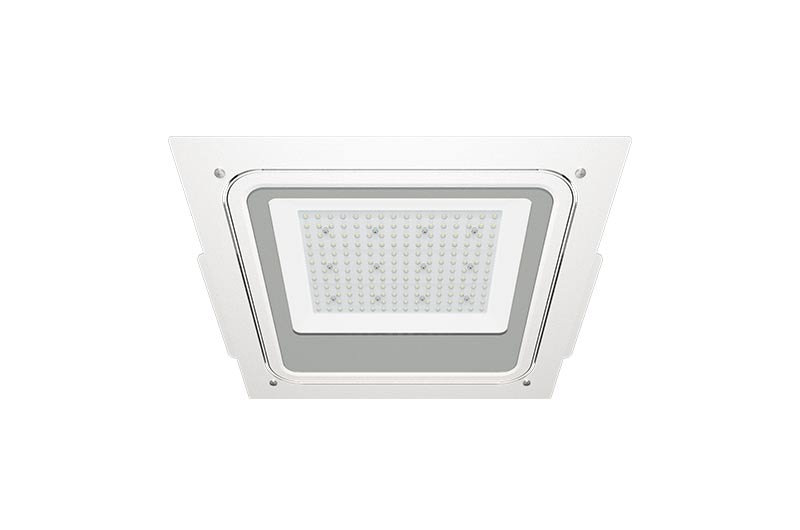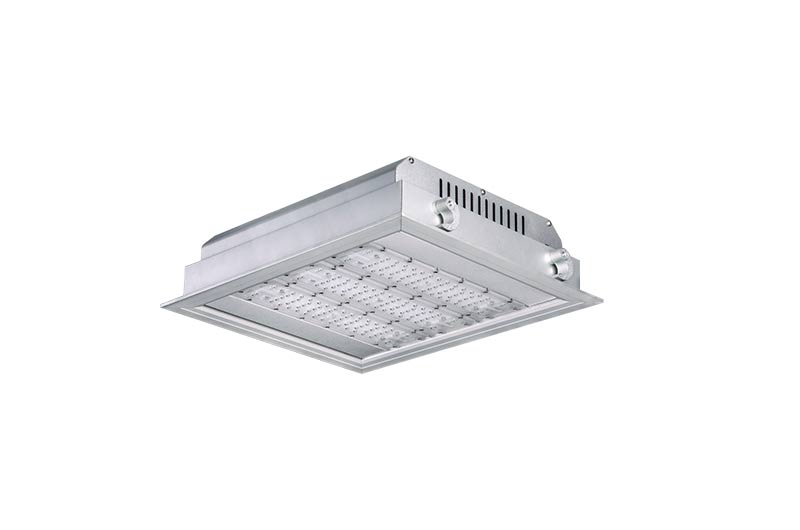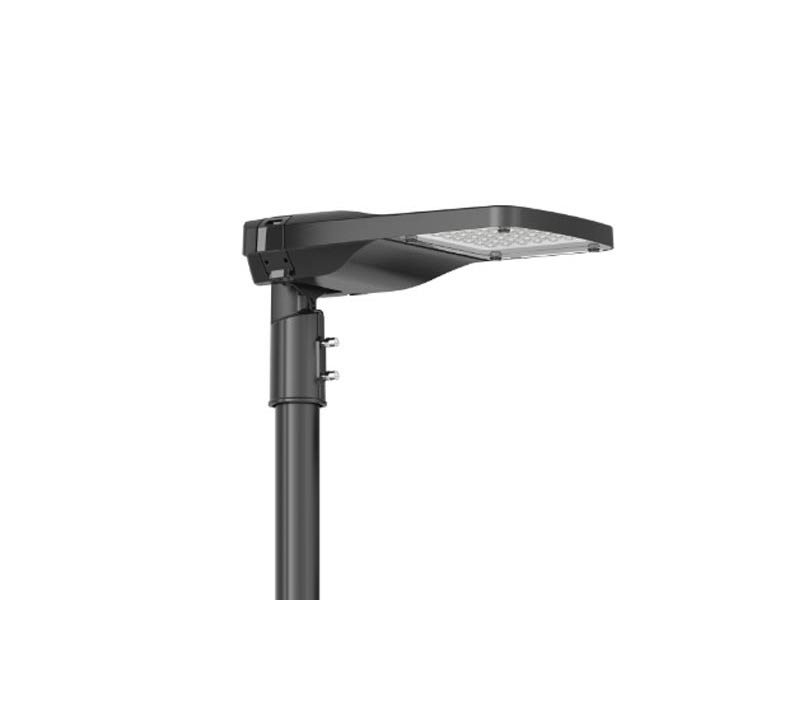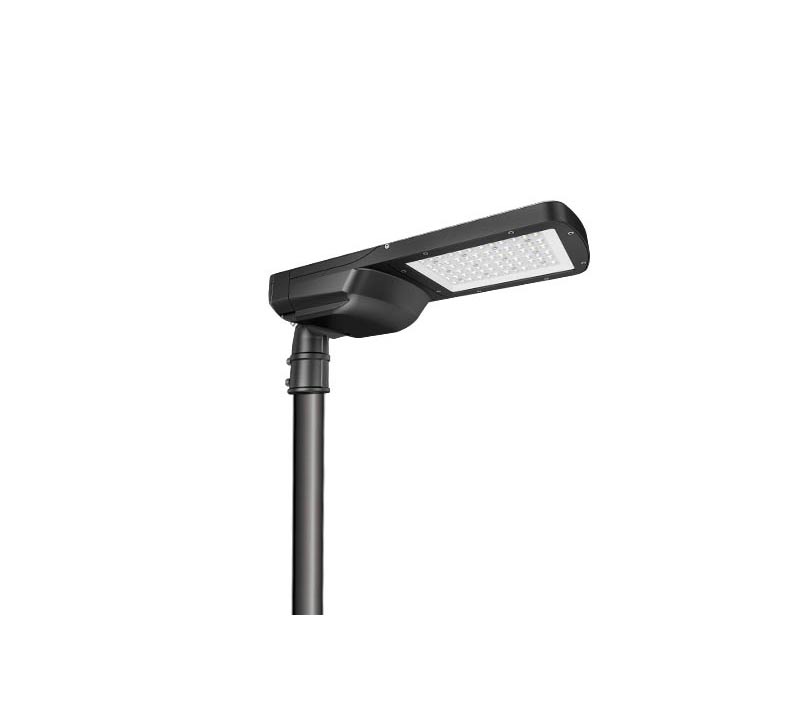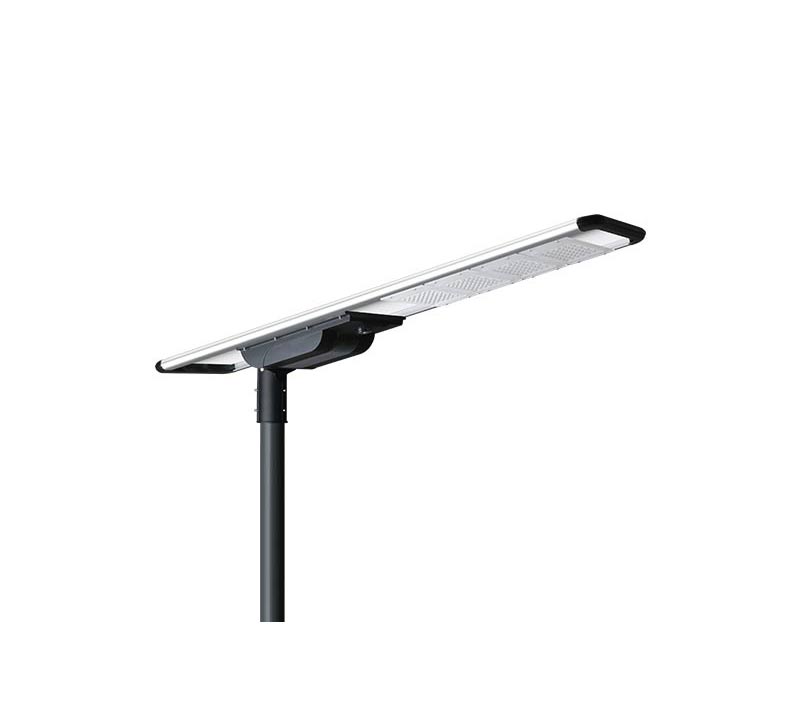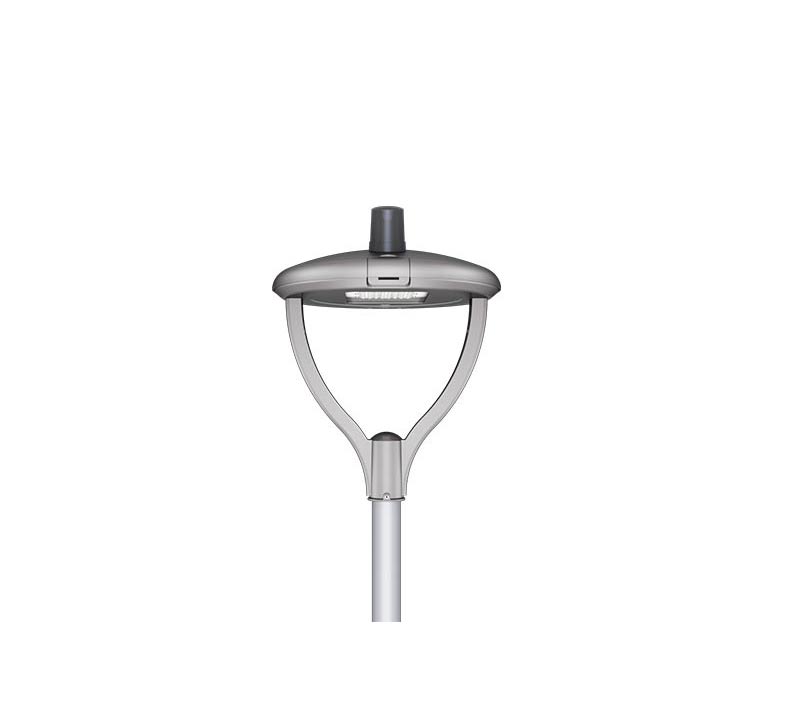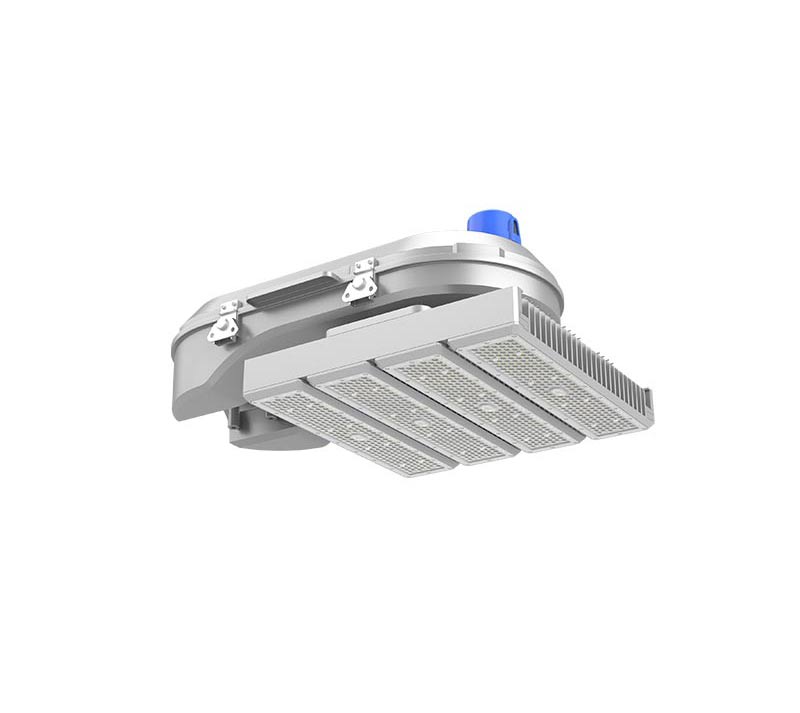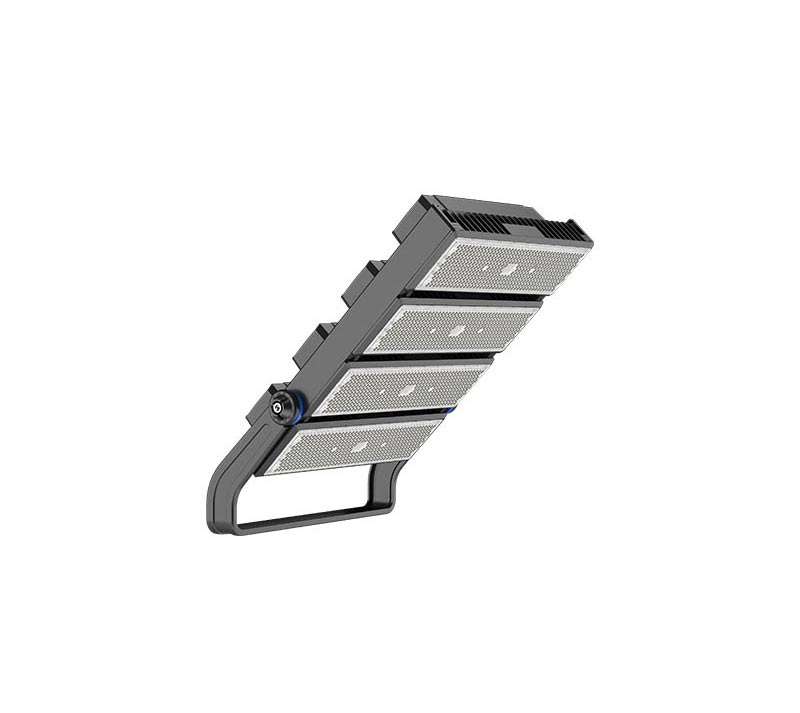
Led Canopy Lights for Petrol station or Service station Lighting
LED canopy lights, as the name suggests, are designed for installation in areas with a canopy overhead, with gas stations being one of the most common applications. While recessed mounting is typical for ceiling of the canopy, surface mounting and suspended options are also available to suit different structural requirements. As a supplier of LED canopy lights, MKLIGHTS offers an array of lighting solutions tailored to your gas station’s specific needs, including ATEX approved LED canopy lights that meet the highest safety standards for hazardous environments.
Types of Canopy Light Fixtures We Offer
MKLIGHTS offers a variety of LED canopy lighting fixtures to meet diverse lighting needs. Our products range from recessed, surface-mounted, and suspended fixtures to ATEX-certified explosion-proof lights and smart control lights with motion sensors. Whether for gas stations, toll booths, or any other locations requiring high-quality canopy lighting, MKLIGHTS can provide the ideal lighting solution to meet the requirements of your project.
ATEX Certified Led Canopy Light for Petrol Station/Service Station
This ATEX-certified led canopy light is specifically designed to be explosion-proof for use in situations with flammable and explosive gases, such as gas stations and service stations. It not only has a high light efficiency and a long service life, but it is also dustproof and waterproof and can work reliably in a variety of severe settings. As a lighting solutions provider, we have always been committed to providing our clients with high-quality products and services.
Modular Design Explosion-proof Led Canopy Light Fixture for Petrol Station
Introducing our new modular design explosion-proof led canopy light fixture, built to fulfill the most severe safety and lighting standards. The innovative modular design not only increases safety but also simplifies maintenance, making it a perfect lighting option for petrol stations that provides exceptional quality and dependability. Choose from our sophisticated LED gas station canopy light fixtures to provide a confident and elegant glow to your petrol station.

Led Canopy Lights Applications
LED canopy lights are engineered to cater to a wide array of applications, offering robust illumination while ensuring energy efficiency. These high-performance lights are ideal for outdoor canopies, providing bright and uniform lighting that is crucial for both functionality and security.
- Gas Stations
- Industrial Sites
- Petrol station
- Service station
- Retail and Commercial Entrances
One of Best Led Canopy Lights Manufacturers and Suppliers in China
As one of the best LED Canopy Light manufacturers and suppliers in China, we provide state-of-the-art lighting solutions to the global market. Our LED Canopy Light series utilizes the latest LED technology to ensure long-term stable operation and reduce maintenance costs. Each product is carefully designed to withstand harsh outdoor environments, with high water and dust resistance ratings, corrosion resistance, and suitability for a variety of climatic conditions. This makes our lighting perfect for gas stations, commercial entrances, parking lots, industrial sites, and any place where efficient and reliable lighting is needed.

Why Choose Led Canopy Lights from MK Lighting?
By choosing MK Lighting for your LED canopy needs, you are selecting a partner that is committed to delivering superior lighting solutions that are designed to meet the highest standards of performance and sustainability.
Customization. We understand that each project has unique lighting needs. MK Lighting offers customizable options in terms of wattage, color temperature, and beam angles to fit your specific requirements.
Smart Features. With options for integrated motion sensors, daylight harvesting, and smart controls, our LED canopy lights are at the forefront of lighting technology, offering you the ability to manage lighting efficiently and reduce operational costs further.
Certifications. MK Lighting’s products meet rigorous quality and safety standards, with certifications from recognized international bodies to back up our claims of product excellence. such as ATEX,CE and etc.
Frequently Asked Questions
Got more questions? We are happy to answer all your queries.
LED canopy lights stand as a paragon of modern illumination, merging superior efficacy with robust design to deliver a lighting solution that excels in coverage and clarity. These fixtures are specifically engineered to cater to the unique demands of outdoor overhead environments such as gas stations, drive-throughs, and commercial walkways. The selection of the correct LED canopy lighting involves a careful evaluation of various technical aspects and features to ensure optimal performance and energy savings. Our guide is meticulously crafted to navigate you through the critical considerations, empowering you to choose the ideal LED canopy lights that align with your specific requirements.
What Are Led Canopy Lights?
LED canopy lights are specialized lighting fixtures designed to be mounted on the underside of an overhang, such as a gas station forecourt, a hotel or hospital entrance, an outdoor walkway, or the canopy of a drive-through. These lights are intended to provide bright, uniform illumination for areas that require good visibility and security. They are an essential feature of many commercial, industrial, and residential lighting designs.
Benefits of Installing Led Canopy Lights
Installing LED canopy lights provides numerous benefits across various dimensions, from energy savings to improved lighting quality. Here are some of the key advantages:
Energy Efficiency: LEDs use significantly less electricity than traditional lighting technologies, such as incandescent or fluorescent lights, which translates into lower energy bills.
Cost Savings: The reduced energy consumption leads to cost savings over time. Additionally, the longevity of LED lights means lower replacement costs and reduced maintenance expenses.
Long Lifespan: LEDs typically have a very long lifespan, often 50,000 hours or more, which is substantially longer than most traditional lighting solutions. This means that once you install LED canopy lights, you won’t have to replace them as frequently.
Better Illumination: LED lighting provides superior illumination. They have excellent color rendering, which means colors appear more natural and vibrant under their light. They can also be designed to offer uniform lighting, reducing shadows and dark spots.
Durability: LEDs are solid-state lights, which means they can withstand bumps, vibrations, and temperature changes better than traditional light bulbs. This makes them ideal for outdoor environments.
Environmental Impact: LEDs are more eco-friendly than many alternatives. They contain no mercury or other hazardous substances and generate less waste because they don’t have to be replaced as often.
Improved Safety: Good lighting is essential for safety, and LED canopy lights provide bright, clear light that improves visibility. This can help reduce accidents and deter criminal activity in outdoor spaces.
Instant On: Unlike some traditional lights that take a while to warm up, LEDs turn on to full brightness instantly.
Reduced Heat Emission: LEDs emit very little heat compared to incandescent bulbs, which release 90% of their energy as heat. This can result in lower air conditioning costs in the summer.
Dimmability: Many LED lighting products are compatible with dimmers, allowing for flexible control over lighting levels which can further enhance energy efficiency and the ambiance of a space.
Rebates and Incentives: Many energy companies and governments provide rebates, incentives, or tax relief for businesses that upgrade to energy-efficient LED lighting.
Compatibility with Control Systems: LEDs can be easily integrated with lighting controls, motion sensors, and smart lighting systems, which can lead to additional energy savings and improved user convenience.
By upgrading to LED canopy lights, facilities can enjoy a modern lighting solution that is cost-effective, environmentally friendly and provides a high-quality lighting experience.
What Are Different Types of Led Canopy Lights?
LED canopy lights come in various designs and specifications to suit different applications and environments, such as gas stations, parking lots, warehouses, and underpasses. Here are some of the common types:
1. Recessed Mount LED Canopy Lights
These are designed to be installed into a recess in the ceiling or canopy, providing a sleek and unobtrusive look. They are often used in gas station canopies, drive-throughs, and outdoor ceilings.
2. Surface Mount LED Canopy Lights
These fixtures are mounted directly onto the surface of the canopy and are easier to install in locations where recessed mounting isn’t possible. They are versatile and can be used in a variety of settings.
3. High-Output LED Canopy Lights
For environments requiring intense levels of light, such as large parking lots or industrial settings, high-output LEDs provide extensive illumination while still maintaining the benefits of energy efficiency.
4. Motion Sensor LED Canopy Lights
Equipped with motion sensors, these lights enhance energy efficiency by lighting up only when movement is detected, making them suitable for low-traffic areas where constant light isn’t necessary.
5. Emergency LED Canopy Lights
These come with a battery backup that allows them to operate even during a power outage, providing critical illumination during emergencies.
6. Smart LED Canopy Lights
Integrated with smart technology, these lights can be controlled and monitored remotely for brightness, and energy consumption, and even scheduled to turn on or off.
7. Marine-grade LED Canopy Lights
For locations near the ocean or in highly corrosive environments, marine-grade lights are built to resist rust and corrosion.
When choosing LED canopy lights, it’s important to consider factors such as the size of the space, the height of the canopy, the level of brightness required, energy efficiency, and whether the lights will be exposed to harsh weather conditions or require special features like dimming or emergency backup. The right type will depend on the specific needs and conditions of the installation site.
Where Are Led Canopy Lights Used?
LED canopy lights are versatile fixtures used in a variety of outdoor and indoor locations where overhead lighting is required. Here are some common places where you might find LED canopy lights being used:
Gas Stations: One of the most common applications, LED canopy lights provide bright, clear lighting under the canopy where vehicles refuel.
Parking Lots and Garages: They are used in parking lots and under the decks of parking garages to ensure good visibility for drivers and pedestrians.
Warehouse and Industrial Areas: For covered loading docks and industrial work areas, LED canopy lights offer reliable illumination that’s critical for safety and operational efficiency.
ATM Kiosks and Drive-Through Banks: Security is paramount in these areas, and bright canopy lighting helps users feel safer when conducting transactions at night.
Hotel and Hospital Entrances: Canopy lights provide a welcoming and safe environment for guests and patients arriving during the evening or early morning hours.
Retail Storefronts: Retail businesses often use canopy lighting in their entryways and covered walkways to enhance visibility and safety for customers.
Public Transport Stations: Train stations, bus stations, and other transit areas with covered shelters use canopy lights to enhance safety and visibility.
Outdoor Walkways: In residential and commercial areas, canopy lights are used to illuminate covered pathways and breezeways.
Quick Service Restaurants (QSRs): Drive-through areas often use canopy lighting to facilitate visibility for both employees and customers during nighttime hours.
Schools and Universities: Educational institutions may use LED canopy lights in covered areas like walkways between buildings or outdoor seating areas.
Stadiums and Arenas: For covered seating areas or concourses, canopy lights improve visibility and contribute to the venue’s overall lighting design.
Loading Docks: Industrial and shipping areas have canopies where trucks load and unload goods, necessitating good lighting for safety and efficiency.
Underpasses and Tunnels: For pedestrian or vehicle underpasses, LED canopy lights provide necessary illumination in otherwise dark environments.
Cold Storage Facilities: Canopy lights designed for cold environments are used in the covered entryways of refrigerated warehouses or storage facilities.
Marinas and Docks: Marine-grade LED canopy lights are used in coastal and marine environments to withstand harsh weather and saltwater exposure.
These lights are valued for their durability, energy efficiency, and the bright, even light they emit, which is essential for visibility and security in the various settings mentioned above.
How to Choose Led Canopy Lights?
Choosing the right LED canopy lights for your application involves several factors to ensure you get the most efficient, cost-effective, and appropriate lighting solution. Here are the key considerations when selecting LED canopy lights:
1. Brightness and Light Output (Lumens)
Calculate the required lumens for your specific area. Generally, brighter lights with more lumens are needed for larger or more trafficked areas.
2. Wattage and Energy Efficiency
Look for lights that provide the best lumens-to-watt ratio to maximize energy savings.
Consider lights with energy-saving features such as dimming capabilities or motion sensors.
3. Color Temperature
Color temperature is measured in Kelvin (K) and affects the look and feel of the space. For example:
3000K provides a warm white light.
4000K provides a neutral or cool white.
5000K and above provides a daylight-like appearance, often preferred for outdoor or industrial settings.
4. Light Distribution and Beam Angle
The fixture should provide uniform light distribution to avoid dark spots.
The beam angle affects how widely the light is spread. A narrower beam angle can focus light on a specific area, while a wider beam angle spreads light over a larger area.
5. Durability and Ingress Protection (IP) Rating
Ensure the fixture is durable and has a high IP rating, indicating it is resistant to dust and water, which is essential for outdoor applications.
6. Certifications and Standards
Look for lights that meet relevant standards and certifications such as ATEX, CE, and ROHS. This can also be important for meeting local building codes or qualifying for energy rebates.
7. Design and Aesthetics
The design of the light fixture should complement the architecture and style of the space.
Consider low-profile designs for a more modern look or go with more traditional designs if they fit the environment better.
8. Mounting Options
Make sure the light fixtures are compatible with the existing mounting setup or determine if new mounting hardware is needed.
9. Environment and Operating Conditions
For extreme environments, choose fixtures rated for specific conditions, such as high humidity, saltwater, or varying temperatures.
10. Electrical Compatibility
Verify that the electrical specifications of the lights are compatible with your existing system to avoid additional electrical work.
11. Integrated Features
Consider features such as integrated photocells for dusk-to-dawn operation or smart controls for energy management and operational efficiency.
12. Lifespan and Reliability
Check the rated lifespan of the LED lights, which can significantly reduce maintenance costs over time.
Review warranties and manufacturer reliability to ensure long-term support and replacement if needed.
13. Cost
Evaluate the total cost of ownership, not just the upfront cost. This includes energy consumption, maintenance, and potential rebates or incentives.
When choosing LED canopy lights, it’s often helpful to consult with a lighting professional or engineer, especially for complex spaces or specialized applications. They can provide a lighting design or photometric analysis to ensure proper light levels and distribution for your specific needs.
How to Install Led Canopy Lights?
Installing LED canopy lights is a task that should be performed by a qualified electrician to ensure safety and compliance with electrical codes. However, if you are familiar with electrical systems and feel comfortable handling this type of installation, here are the general steps you might follow:
Tools and Materials Needed
LED canopy lights
Ladder or lift (depending on the height of the canopy)
Screwdrivers (Phillips or flat-head as required)
Wire strippers
Wire nuts or suitable connectors
Electrical tape
Drill with appropriate bits
Anchors and screws (if not provided with the light fixture)
Voltage tester
Safety glasses and gloves
Safety Precautions
Turn off the power at the circuit breaker or fuse box before starting the installation to prevent electrical shock.
Verify that the power is off using a voltage tester.
Wear safety glasses and gloves to protect against debris and sharp edges.
Installation Steps
1. Prepare the Area:
Ensure the area is clean and safe to work in.
Position the ladder or lift it securely.
2. Remove the Existing Fixture (if applicable):
Take down any existing fixtures carefully, disconnecting the wiring after ensuring the power is off.
3. Prep the New LED Canopy Light:
Unbox and prepare the new light fixture according to the manufacturer’s instructions.
If a mounting template is provided, use it to mark the drill holes.
4. Drill Mounting Holes (if necessary):
Use a drill to create holes for the new fixture if the existing holes do not align. Make sure to use appropriate anchors for your canopy material.
5. Connect the Electrical Wires:
Route the electrical wires through the mounting plate or directly into the fixture, if applicable.
Connect the ground wire (usually green or bare) from the fixture to the ground wire from the power source.
Connect the live wire (usually black or red) from the fixture to the live wire from the power source.
Connect the neutral wire (usually white) from the fixture to the neutral wire from the power source.
Use wire nuts or connectors to secure the wire connections and apply electrical tape to prevent exposure.
6. Secure the Fixture:
Align the fixture with the mounting holes and secure it with screws or bolts.
Ensure that it is firmly attached to the canopy without overtightening, which could damage the fixture or the canopy.
7. Finalize the Installation:
Install any diffusers or lenses that come with the fixture.
Double-check all connections and make sure the fixture is securely mounted.
8. Test the Installation:
Turn the power back on at the circuit breaker or fuse box.
Switch on the light to test its operation.
If the light does not work, turn off the power again and re-check the wire connections.
9. Cleanup:
Once confirmed the light is working, clean up your work area.
Dispose of or recycle the old fixture appropriately.
Remember, these are general guidelines, and your specific LED canopy light may have different requirements or steps for installation. Always follow the manufacturer’s instructions and local electrical codes. If you are unsure about any aspect of the installation, it is best to hire a professional electrician.
Conclusion
Selecting the ideal LED canopy lights is pivotal in transforming outdoor shelters, gas stations, and commercial overhangs into secure, inviting, and efficiently illuminated spaces. Superior lighting is not just about enhancing ambiance—it’s also critical for safety and operational effectiveness. Explore the diverse array of LED canopy lighting solutions offered by MK Lighting, or engage with our specialists for a personalized consultation. Our team is dedicated to guiding you through the nuanced selection process, ensuring that you obtain a lighting solution that is not only powerful and energy-saving but also perfectly tailored to the unique demands of your canopy-covered environment. Allow us to illuminate your space with precision-engineered LED canopy lights that promise durability, performance, and aesthetic appeal.

